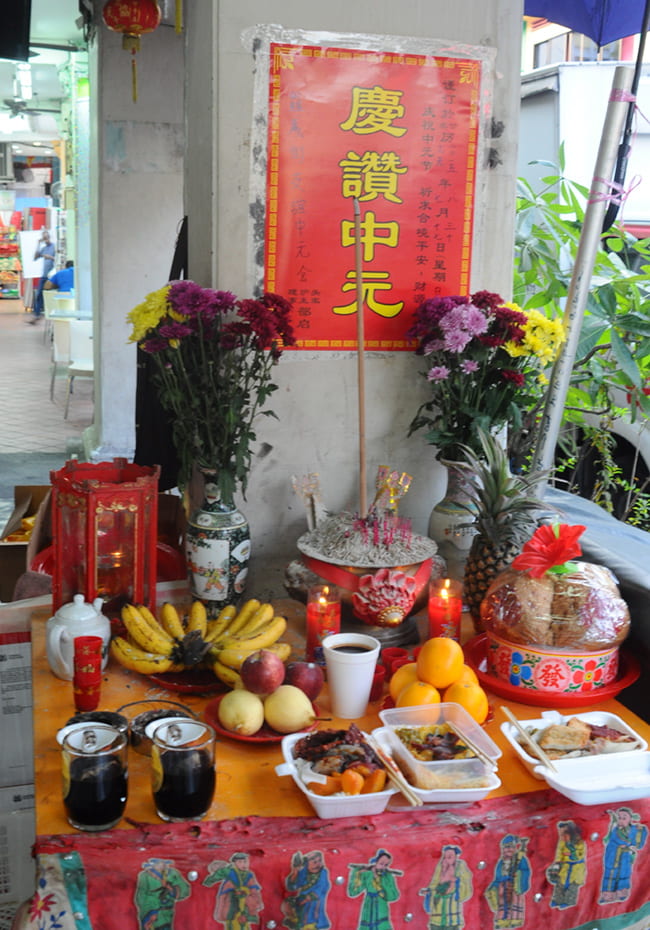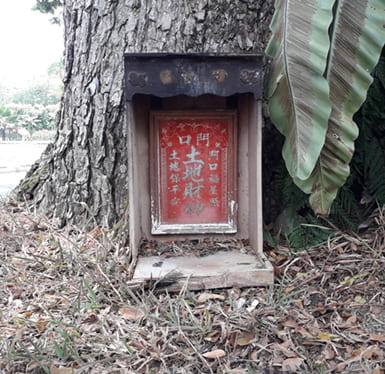
Dialogue
Making Belief in the Singapore Army
Ritual spaces and objects in a Singapore Army camp give voice to a deeper hunger.
Photo courtesy Theophilus Kwek
By Theophilus Kwek
“Best not to forget the dead,” says Sheng, “since they don’t ever forget us.”
Heads bob around the table as steam rises from our bowls of prawn noodles. But Hui is doubtful. “Even here, in the camp?”
“Yes, even here.”
It’s slightly past noon, and in the sprawling base where I have been posted for two years of mandatory National Service, lunch is served to nearly a thousand troops with industrial efficiency. This morning has been slow, indistinguishable from others except for being the eve of the Seventh Month, when—in a handful of diasporic Chinese traditions, including ours—the doors of the dead are flung wide open. We’ve all heard the stories: fruit offerings, left in quiet corridors, neatly peeled and eaten during the night; a sweet scent or haze announcing a long-awaited relative.
The men aren’t taking any chances. They swap notes over how to pray (and to whom, and where) so as to appease the itinerant ghosts, and as we leave the cookhouse, conversation turns to recent bereavements in our families (or who might be expecting a visit from whom). Later, though, my suspicions are confirmed. Several tell me privately that they wouldn’t have spoken as openly with classmates, partners, or, for some, close family members. Far easier, they say, to discuss such matters within the fenced, unassuming ambit of the camp—among colleagues and friends—even if more visible trappings of religion hold sway in the world outside.
Just before the annual monsoon makes landfall, joss fires are kept burning in metal urns to last through the Ghost Festival, leaving a film of ash across the country. Despite the pointedly secularist position of her government (part of a long-standing commitment to official multiculturalism), Singapore’s meteoric transformation into a glittering “Intelligent Island” has been accompanied by a popular rediscovery of faith, from the spread of Pentecostal Christianity among the middle class, to the proliferation of Buddhist and Islamic youth associations and house gatherings. Yet, personal beliefs still sit awkwardly alongside the global city’s other imperatives: academic excellence, economic progress, and, above all, an unyielding drive for a modern, technocratic image that conveys first-world status.
♦♦♦
I notice them on my evening walks around the camp: makeshift altars in light containers, some no bigger than a shoebox. Closed on three sides, they contain low shelves on which the statues of various deities are arranged, while their ridged awnings provide shelter from birds and tropical rain. Some are stand-alone fixtures, partially hidden by low foliage; others are nailed to walls and pillars at shoulder-height, with figurines gaily painted to catch the eye. There’s one behind the main cookhouse and another by a training shed, a stone’s throw from the block’s designated smoking corner.
The camp buildings themselves, though hardly spartan, contrast with these festive aberrations. It doesn’t take much—discolorations in the concrete floor, a broom left nearby for clearing the ashes—to demarcate zones of reverence with subtle precision: where one should stand to pay respects, or leave offerings on paper plates. Such ritual spaces, unremarkable and passed through by those in a hurry, carve out pockets of otherworldly significance in the life-and-death reality of the camp, places where the regular rhythms of discipline and hierarchy do not easily apply. For the devout, they are exceptions within the camp’s exception, suspending one imposed order in favor of another.

Photo courtesy Theophilus Kewk
Other uncommon spaces make the camp a diverse geography. Crucifixes dangle from unshowy chains pinned to office walls, while nondescript rooms are set aside for our Muslim colleagues’ Friday prayers. Not infrequently, multiple traditions claim the same niche. One altar houses the portly figure of Tua Pek Kong, venerated as the head of the Southeast Asian folk pantheon, with statues of Guan Yin (shared by Taoist and Mahayana Buddhist devotees) and the Hindu goddess Kali on either side. In the late hours, Cantonese-speaking chefs come here to pray alongside the Tamil-speaking construction staff, each tending to their own gods. The camp, one could say, is a broad church.
Following the tumult of the Second World War, anthropologists like Victor Turner developed pathbreaking ways to understand how ritual might help to structure (and restructure) our societies and lives. Since then, scholarly attention has turned toward investigating ritual geographies, spaces drawn into and patterned by our practices of reverence or foreboding. Tracing the camp’s perimeter, my route transects the seen and unseen thresholds of those who worship here, as well as the invisible histories of this site—it was a residential area before the camp was built—that remain hidden in its slopes and hollows.
But the ritual geography of the camp is also manifest in a more immediate sense. For its conscript inhabitants, its squares and walkways are overlaid by the cadences of patrol and punishment. Under close supervision, a liturgy of memorized orders and marching songs takes precedence. Formulaic compliments enshrine the camp’s hierarchy of command, and a roster of servicemen keep a nightly vigil. Such rituals carefully structure disparate lives around the battalion’s demands and ensure the success and safety of its short-term missions, all of which are underwritten by a grand narrative of national security.
How are we to read the two sets of ritual spaces against each other? Are the footholds of faith littered across the camp at once transcendent and incongruous? Should we read them as attempts to reinscribe meaning within an oppressive landscape, or merely as cracks in the military’s totalizing mythos, through which the servicemen’s inner and communal lives may be glimpsed—if only momentarily? By the time I head back toward the barracks, the camp is already cloaked in dusk: except, that is, for the laser-red points of lit joss-sticks winking under their aluminum roofs, sending a warm, slow pulse into the restless dark.
♦♦♦
“We will always bear true faith . . .”
On the first morning of every recruit’s National Service, he (only males are subject to conscription) is ushered into an air-conditioned hall in one of Singapore’s offshore training facilities and made to recite the pledge of the Singapore Armed Forces while parents, siblings, and girlfriends look on. Right palm raised—voice shaking ever so slightly—he swears loyalty to the republic and its president, promises to defend the constitution, and seals it with the ultimate wager: “with our lives”!
Over the following weeks, the intensity of belief in these words fades, as it must, into the texture of other rituals. We are taught to waterproof our belongings, smear camouflage paint several millimeters thick across our faces, and, when called upon, shoot to kill. In its lavish public relations efforts, from free-to-air soap operas to ubiquitous advertising campaigns, the army self-consciously portrays the two years spent within the organization less as a costly sacrifice (though no one quite denies that) than as a rite of passage, marking one’s transition into manhood.
Bound up in the hardheaded calculations of defending an increasingly open, and hence ever-more-insecure city, are several modern myths, easily glossed over in the rush to justify higher defense budgets and extensive conscription protocols. Narratives of perennial threat and resource scarcity, repeated so often in the public media as to become familiar, resonate with prophecies of timely salvation from terrorist plots or with parables of endemic class and race divides vanishing among the rank and file. Even in Singapore, where levels of bureaucratic trust are unusually high, nothing less than true faith in the army’s necessity is required to keep the system well oiled and the men content.
The veracity of these myths is, to me, less interesting than how those whose paths now cross daily with mine—fellow servicemen, civilian staff, migrant laborers, army regulars—must choose to live within their contours. From this perspective of choice, the re-articulation of belief against the camp’s barren backdrop might all too easily be parsed as a collective reassertion of our individual lives, lives whose trajectories have been enlisted to a singular purpose. Spaces set aside for worship give voice to another hunger, a search, perhaps, for more than personal and national survival.
Yet, to parse faith as a choice would be to miss the point entirely. Whether they have been convinced by tradition, epiphany, or “merely” the accumulation of small sureties, all true believers must surrender the notion that they have chosen one truth over another. Faith, after all, requires that the inescapable exists beyond ourselves—and may only be submitted to, not opted for. Why believe otherwise, in either the gods of hearth or nation? We do not remember the dead; it is they who remember us. And so the fires must be kept, the altars replenished every morning.
♦♦♦
A postscript.
One evening, my walk takes me to where I can look out over the surrounding forest to the wide river beyond. A man is kneeling on the grassy rise; from where he is, the barbed-wire boundary seems to disappear. I stand and watch as he briefly raises, then lowers his arms.
I close my eyes, as I know his are.
For a spell, it almost seems like there is nothing else in the camp that matters, no one to share in the evening’s calm expanse.
No one, of course, but him and his God.
Theophilus Kwek is the author of five collections of poetry, most recently The First Five Storms, a winner of the 2015/16 New Poets Prize awarded by The Poetry Business. Having recently completed an MSc in refugee and forced migration studies at Oxford University, he is now based in Singapore as a writer and researcher. He serves as co-editor of Oxford Poetry.
Please follow our Commentary Guidelines when engaging in discussion on this site.

